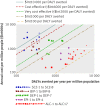Cost effectiveness of strategies to combat neuropsychiatric conditions in sub-Saharan Africa and South East Asia: mathematical modelling study
- PMID: 22389339
- PMCID: PMC3292519
- DOI: 10.1136/bmj.e609
Cost effectiveness of strategies to combat neuropsychiatric conditions in sub-Saharan Africa and South East Asia: mathematical modelling study
Abstract
Objective: To assess the comparative costs and effects of interventions to combat five neuropsychiatric conditions (schizophrenia, bipolar disorder, depression, epilepsy, and heavy alcohol use).
Design: Cost effectiveness analysis based on an epidemiological model.
Setting: Two epidemiologically defined World Health Organization sub-regions of the world: countries in sub-Saharan Africa with very high adult and high child mortality (AfrE); and countries in South East Asia with high adult and high child mortality (SearD).
Data sources: Published studies, costing databases.
Main outcome measures: Cost per capita and cost per disability adjusted life year (DALY) averted, expressed in international dollars ($Int) for the year 2005.
Results: Across 44 assessed intervention strategies for the five neuropsychiatric conditions, cost effectiveness values differed by as much as two orders of magnitude (from $Int100-250 to $Int10,000-25,000 for a year of healthy life gained). In both sub-regions, inpatient based treatment of schizophrenia with newer antipsychotic drugs was the most costly and least cost effective strategy. The most cost effective strategies in the African sub-region related to population based alcohol control, while in the South East Asian sub-region the most cost effective intervention was drug treatment of epilepsy in primary care. The cumulative cost per capita of the most cost effective set of interventions covering all five conditions was estimated at $Int4.90-5.70. This package comprises interventions for epilepsy (older first line antiepileptic drugs); depression (generically produced newer antidepressants and psychosocial treatment); bipolar disorder (mood stabiliser drug lithium); schizophrenia (neuroleptic antipsychotic drugs and psychosocial treatment); and heavy alcohol use (increased taxation and its enforcement, reduced access, and, in the African sub-region, advertising bans and brief advice to heavy drinkers in primary care).
Conclusions: Reallocation of resources to cost effective intervention strategies would increase health gain, save money and help implement much needed expansion of services for neuropsychiatric conditions in low resource settings.
Conflict of interest statement
Competing interests: All authors have completed the ICMJE uniform disclosure form at
The authors are staff members of the WHO. The authors alone are responsible for the views expressed in this publication and they do not necessarily represent the decisions, policy, or views of the WHO.
Figures




References
-
- Saxena S, Thornicroft G, Knapp M, Whiteford H. Resources for mental health: scarcity, inequity and inefficiency. Lancet 2007;370:878-89. - PubMed
-
- Jacob KS, Sharan P, Mirza I, Garrido-Cumbrera M, Seedat S, Mari JJ, et al. Mental health systems in countries: where are we now? Lancet 2007;370:1061-77. - PubMed
-
- Demyttenaere K, Bruffaerts R, Posada-Villa J, Gasquet I, Kovess V, Lepine JP, et al. Prevalence, severity, and unmet need for treatment of mental disorders in the World Health Organization World Mental Health Surveys. JAMA 2004;291:2581-90. - PubMed
-
- World Health Organization. mhGAP: Mental Health Gap Action Programme: scaling up care for mental, neurological and substance use disorders. WHO, 2008. - PubMed
